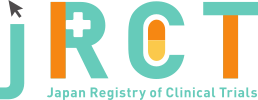臨床研究等提出・公開システム
|
Sept. 13, 2022 |
|
|
July. 17, 2025 |
|
|
jRCT2031220333 |
A phase III study to evaluate the efficacy and safety of M605110 in patients with acne vulgaris |
|
A phase III study to evaluate the efficacy and safety of M605110 in patients with acne vulgaris |
|
Mar. 23, 2023 |
|
248 |
|
No bias was found in demographic characteristics between the groups. Overall, in the clinical study, the gender ratio of the patients was 1:1, and mean age (standard deviation: SD) was 20.7 (6.9) years, with more than 90% of the age distribution being under 30 years. No bias in the baseline lesion count between the groups was observed. Overall, in the clinical study, the mean of total lesion count (SD) was 57.9 (20.4), with the mean of inflammatory and non-inflammatory lesion count (SD) being 18.9 (7.2) and 39.0 (18.2), respectively. |
|
This study consisted of the screening period and the treatment period. In the treatment period, patients were randomly assigned to receive the 5% M605110 or the M605110 vehicle. Of the patients who consented to participate in the study, 248 were randomized, and all of them (5% M605110 group: 120 patients, M605110 vehicle group: 128 patients, in the same order as listed below) received the Investigational Product (IP). A total of 244 patients (118 and 126, respectively) completed the study, while 4 patients (2 in each group) discontinued the study. |
|
The incidence of adverse events (AEs) was 35.0% in the 5% M605110 group and 43.0% in the M605110 vehicle group. Of these, the incidence of AEs related to the IP was 15.8% in the 5% M605110 group and 11.7% in the M605110 vehicle group, all of which were mild in severity. No deaths were observed. Other serious adverse events, not related to the IP, included contusion in one patient in the 5% M605110 group and ovarian neoplasm in one patient in the M605110 vehicle group. No AEs leading to discontinuation or interruption of the IP were observed. One patient experienced an AE (application site erosion) leading to dose reduction was observed in the M605110 vehicle group, which was not related to the IP. The incidence of AEs corresponding to skin irritation symptoms was 19.2% in the 5% M605110 group and 13.3% in the M605110 vehicle group. All such AEs were mild in severity, and the outcomes were recovered or recovering, except for one patient with eczema in the 5% M605110 group that did not recover. Among the common AEs, the incidence of which in the 5% M605110 group was higher than in the M605110 vehicle group, and which were related to the IP, were application site erythema 5.8% and application site irritation 4.2%. No AEs corresponding to systemic hypersensitivity reactions were observed. No clinically significant changes were observed in the laboratory tests results. Skin safety scores showed no differences between the groups for both scales and erythema. The proportion of patients scoring 0 was over 90% in each group at the start of treatment and on each evaluation day after the administration of the IP. |
|
For the primary endpoint, the least squares mean of percentage reduction of total lesion count at Week 12 was 55.90% for the 5% M605110 group and 43.85% for the M605110 vehicle group. The difference (two-sided 95% confidence interval) in the least squares mean between the 5% M605110 group and the M605110 vehicle group was 12.05% (3.70% to 20.39%), indicating that the percentage reduction at Week 12 in the 5% M605110 group was statistically significantly higher than that in the M605110 vehicle group (P = 0.0048). For the secondary endpoints, percentage reduction of inflammatory and non-inflammatory lesion count at Week 12, reduction of total lesion count, inflammatory lesion count and non-inflammatory lesion count showed an improvement trend in the 5% M605110 group compared to the M605110 vehicle group, similar to the results of the primary endpoints. The percentage of patients who achieved an Investigator's Global Assessment (IGA) score improvement of more than 2 grades and an IGA score reached 0 or 1 at Week 12 was 16.5% in the 5% M605110 group, which was higher compared to 8.7% in the M605110 vehicle group. |
|
As a short contact therapy for patients with acne vulgaris, 5% M605110 was applied and then washed off after 5-10 minutes, once daily for 12 weeks on the face. The results showed that the efficacy was positive, and the tolerability was favorable. |
|
July. 22, 2025 |
|
June. 24, 2025 |
|
No |
|
https://jrct.mhlw.go.jp/latest-detail/jRCT2031220333 |
Tomoyuki Nishiura |
||
Maruho Co.,Ltd. Kyoto R&D Center |
||
93 chudoji Awatacho, Shimogyo-ku, Kyoto |
||
+81-75-325-3279 |
||
ctinfo@mii.maruho.co.jp |
||
Clinical Trials Information - |
||
Maruho Co.,Ltd. Kyoto R&D Center |
||
93 chudoji Awatacho, Shimogyo-ku, Kyoto |
||
+81-75-325-3279 |
||
ctinfo@mii.maruho.co.jp |
Complete |
Sept. 13, 2022 |
||
| Sept. 30, 2022 | ||
| 240 | ||
Interventional |
||
randomized controlled trial |
||
double blind |
||
placebo control |
||
parallel assignment |
||
treatment purpose |
||
Patients with Acne vulgaris 9 to 49 years old |
||
(1)Patients with concurrent presense of serious cardiac, hepatic, renal, plumonary, hematologic, or other diseases considered inappropriate for paticipation in the clinical study |
||
| 9age old over | ||
| 49age old under | ||
Both |
||
Acne vulgaris |
||
Apply an appropriate amount of M605110 once a day. |
||
Percentage change in total lesion count |
||
| Maruho Co.,Ltd. |
| Maebashi Hirosegawa Clinic IRB | |
| 2-10-9, Chiyodamachi, Maebashi-shi, Gunma | |
+81-3-5543-0196 |
|
| jimukyoku@smo-msr.co.jp | |
| Approval | |
Aug. 31, 2022 |
none |
